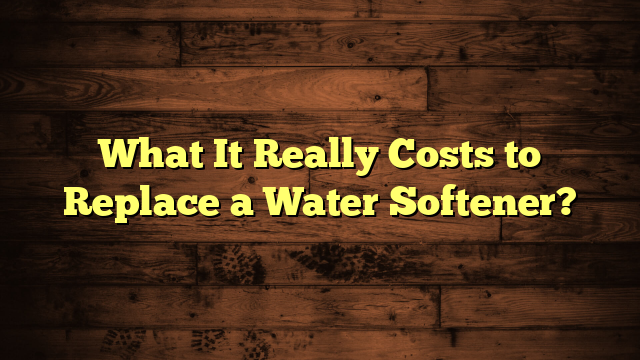What It Really Costs to Replace a Water Softener?
Replacing a water softener can be a bit of an investment in your home's comfort. You might think the initial price tag is where the story ends, but there's much more to take into account. From installation fees to ongoing maintenance, the costs can add up quickly. Plus, you'll want to factor in potential changes to your utility bills and water usage over time. So, what should you really expect to spend when you take this important step? Let's break it down together.
Key Takeaways
- Replacement costs for water softeners typically range from $400 to $4,000, depending on the type and features selected.
- Installation expenses can add another $200 to $600, including permits and professional fees.
- Regular maintenance, such as salt checks and brine tank cleaning, incurs ongoing expenses to ensure efficiency.
- Higher utility bills may result from softened water due to increased energy and water usage during regeneration.
- Budgeting for potential repair costs is essential to avoid unexpected expenses post-installation.
Understanding Water Softener Types
When it comes to choosing a water softener, understanding the different types available can make all the difference.
You'll find that salt-based systems are among the most common options. These systems work by exchanging hardness ions in your water with sodium ions, effectively softening it. Many homeowners prefer salt-based systems due to their efficiency and reliability.
Another option to evaluate is dual tank systems. These systems are designed to guarantee a continuous supply of softened water. While one tank is in use, the other regenerates, meaning you won't experience downtime during the softening process. This can be especially beneficial for larger households where demand for softened water is high.
It's also worth noting that each type has its pros and cons. For instance, salt-based systems might require regular maintenance and salt replenishment, while dual tank options can be more expensive upfront.
Average Cost of Water Softeners
The investment in a water softener can greatly impact your household's comfort and water quality. When considering a new unit, understanding the average cost is vital for effective budget planning. Prices typically range from $400 to $4,000, depending on the type, capacity, and features you choose.
To help you grasp the potential impact on your wallet, here's a brief overview of what you might consider:
- Improved water quality enhances your skin and hair health.
- Longer-lasting appliances save you money in the long run.
- Reduced soap usage means less spending on cleaning products.
Conducting an average price comparison among different brands and models will aid in your decision-making process.
Don't forget to factor in long-term costs like maintenance and salt, as these can add up. By planning your budget accordingly, you can guarantee you select a water softener that fits your needs without breaking the bank.
Ultimately, investing wisely in a quality water softener can lead to a more comfortable and cost-effective lifestyle, making it a decision that pays off in numerous ways.
Installation Expenses to Consider
Installation costs can vary greatly based on factors like your home's plumbing setup and the complexity of the installation process. Before diving into the actual work, you'll need to take into account several expenses that can impact your budget.
One major expense is installation permits, which are often required by local codes. These permits guarantee the work is done to standard, but they can add to your overall costs. Moreover, hiring professionals for the installation can greatly influence your expenses. While DIY might save you money, it can also lead to costly mistakes if you're not familiar with plumbing systems.
Here's a quick overview of installation expenses to take into account:
| Expense Type | Estimated Cost |
|---|---|
| Installation Permits | $50 – $150 |
| Professional Fees | $200 – $600 |
| Equipment Rental | $50 – $100 |
| Miscellaneous Supplies | $20 – $50 |
Maintenance and Repair Costs
Maintaining your water softener is essential for its longevity and performance, and it comes with its own set of costs. Regular upkeep can help you avoid costly repairs down the line, but you should be prepared for some expenses along the way.
Here are some maintenance tips to keep in mind:
- Check salt levels regularly to guarantee peak efficiency.
- Clean the brine tank at least once a year to prevent buildup.
- Monitor repair frequency and address issues promptly to avoid bigger problems.
Additional Accessories and Supplies
When considering a water softener, it's important to factor in supplementary accessories and supplies that can enhance its performance and efficiency. Various fitting requirements can dictate the necessary accessories for your system.
For example, you might need specific connectors or adapters to guarantee a seamless installation. It's vital to check your plumbing setup before making purchases to avoid any compatibility issues.
Salt types also play a significant role in the effectiveness of your water softener. You'll find options like rock salt, solar salt, and evaporated salt, each with its benefits and drawbacks.
Understanding these salt types helps you select the best one for your system, ensuring peak performance.
You may also want to invest in a pre-filter, which can help reduce sediment buildup, prolonging your water softener's life.
Furthermore, storage containers for salt can keep your supply organized and easily accessible.
Energy and Water Usage Impacts
Considering the energy and water usage impacts of a water softener can greatly affect your overall cost and environmental footprint.
Water softeners can lead to increased water and energy consumption, impacting both your wallet and the planet. It's crucial to be aware of these factors to make informed decisions.
- Higher utility bills: Softened water often requires more energy for heating.
- Increased water waste: Regeneration cycles can lead to excessive water use.
- Environmental impact: More energy consumption can contribute to a larger carbon footprint.
By prioritizing energy efficiency and water conservation, you can mitigate these issues.
Look for modern, high-efficiency models that minimize water usage during regeneration, and consider using a demand-initiated regeneration system. These systems only regenerate when necessary, saving both water and energy.
Moreover, maintaining your water softener regularly can guarantee peak performance, reducing unnecessary energy costs.
When you're mindful of energy and water usage, you not only save money but also do your part in preserving our precious resources for future generations.
This awareness can lead to significant long-term benefits, both financially and environmentally.
Long-Term Financial Considerations
Understanding the long-term financial implications of replacing a water softener is just as important as evaluating its immediate costs. While the initial price tag might catch your attention, the total cost over time can greatly impact your budget.
When you factor in maintenance, energy, and salt usage, the numbers can add up quickly. To guarantee you're making a sound investment, consider effective budgeting strategies.
First, assess how much you're currently spending on water-related issues, like higher utility bills due to hard water damage. Then, calculate the potential savings a new softener could bring.
You might also want to explore financing options or seasonal sales to lighten the upfront financial burden. Remember, a quality water softener can extend the life of your plumbing and appliances, translating to long-term savings.
Finally, keep an eye on warranties and service plans. A solid warranty can save you from unexpected repair costs down the line, making it easier to manage your finances.
Frequently Asked Questions
How Long Do Water Softeners Typically Last Before Replacement?
Water softeners typically last around 10 to 15 years, depending on usage and maintenance. To extend your water softener lifespan, follow maintenance tips like regular cleaning and salt replenishment to keep it running efficiently.
Can I Replace My Water Softener Myself?
You can replace your water softener yourself, and it's a great way to achieve cost savings. Just make sure you follow the DIY installation instructions carefully to avoid potential issues and guarantee peak performance.
What Signs Indicate My Water Softener Needs Replacement?
If your water quality deteriorates, like increased hardness or unpleasant taste, it might be time to replace your water softener. Regular maintenance tips include checking for leaks and ensuring the salt levels are adequate.
Are There Eco-Friendly Water Softener Options Available?
Imagine your home as a thriving garden; eco-friendly water softeners nurture it. You'll find sustainable options made from eco-friendly materials that reduce environmental impact while keeping your water soft and your conscience clear. Explore those choices today!
Does Water Hardness Affect the Lifespan of a Water Softener?
Yes, water hardness greatly affects your softener's lifespan. Harder water forces the system to work harder, leading to more frequent regeneration cycles and potential wear. Regular maintenance can help extend your softener's life despite water hardness challenges.
Conclusion
In conclusion, replacing a water softener isn't just about the initial purchase; it's a multifaceted investment. While you might find the upfront costs manageable, it's wise to contemplate installation, maintenance, and potential utility impacts. By budgeting mindfully and accounting for all aspects, you're not merely buying a device; you're ensuring a long-term solution for your home. Embrace this opportunity to enhance your water quality, knowing that a little foresight today can lead to considerable benefits tomorrow.







